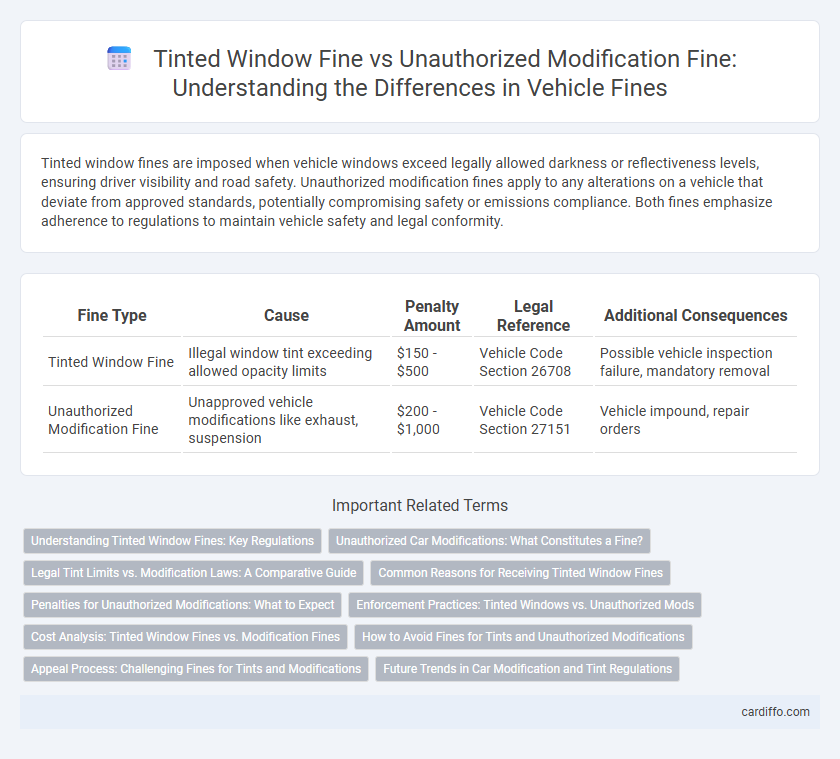Tinted window fines are imposed when vehicle windows exceed legally allowed darkness or reflectiveness levels, ensuring driver visibility and road safety. Unauthorized modification fines apply to any alterations on a vehicle that deviate from approved standards, potentially compromising safety or emissions compliance. Both fines emphasize adherence to regulations to maintain vehicle safety and legal conformity.
Table of Comparison
| Fine Type | Cause | Penalty Amount | Legal Reference | Additional Consequences |
|---|---|---|---|---|
| Tinted Window Fine | Illegal window tint exceeding allowed opacity limits | $150 - $500 | Vehicle Code Section 26708 | Possible vehicle inspection failure, mandatory removal |
| Unauthorized Modification Fine | Unapproved vehicle modifications like exhaust, suspension | $200 - $1,000 | Vehicle Code Section 27151 | Vehicle impound, repair orders |
Understanding Tinted Window Fines: Key Regulations
Tinted window fines vary based on the degree of tint darkness and local legal limits, with penalties often including monetary fines and possible vehicle inspection failures. Unauthorized modification fines apply when window tints exceed permissible standards or lack proper certification, reflecting strict enforcement to ensure driver safety and visibility. Understanding key regulations involves reviewing state-specific tint percentage allowances and the required compliance documentation to avoid costly penalties.
Unauthorized Car Modifications: What Constitutes a Fine?
Unauthorized car modifications often result in fines when they violate vehicle safety standards or local regulations, including illegal tinting, exhaust changes, or suspension alterations. Authorities impose fines based on the severity and type of modification, with tinted windows commonly fined if they exceed permitted light transmission levels, typically below 35%. Fines for unauthorized modifications serve to ensure road safety, maintain vehicle compliance, and prevent potential hazards caused by unapproved alterations.
Legal Tint Limits vs. Modification Laws: A Comparative Guide
Legal tint limits regulate the permissible darkness of window films to ensure driver visibility and safety, often defined by percentage of visible light transmission (VLT). Unauthorized modification fines are imposed when vehicle alterations, including tint levels exceeding legal thresholds or illegal tint types like reflective films, violate local vehicle regulations. Understanding the specific VLT requirements and modification laws in each jurisdiction helps drivers avoid penalties and maintain compliance with road safety standards.
Common Reasons for Receiving Tinted Window Fines
Common reasons for receiving tinted window fines include exceeding the legal tint darkness allowed by state regulations and using prohibited materials that reduce visibility for law enforcement. Unauthorized modifications, such as applying non-transparent films or coverings that do not comply with vehicle safety standards, also result in penalties. Law enforcement officers often issue fines during routine traffic stops or vehicle inspections when tinted windows obstruct clear vision or impair vehicle safety features.
Penalties for Unauthorized Modifications: What to Expect
Penalties for unauthorized modifications, including tinted windows, often involve fines that vary by jurisdiction but typically range from $100 to $500 or more per violation. Law enforcement may also mandate removal of the non-compliant tint and reinspection to ensure compliance with vehicle regulations. Repeat offenses can result in increased fines, vehicle impoundment, or suspension of vehicle registration, emphasizing the importance of adhering to authorized modification standards.
Enforcement Practices: Tinted Windows vs. Unauthorized Mods
Enforcement practices for tinted windows typically involve measuring visible light transmission (VLT) levels using specialized devices to ensure compliance with state regulations, with fines issued primarily based on the degree of tint darkness. Unauthorized modifications, such as altered exhaust systems or lifted suspensions, attract fines often linked to safety inspections and adherence to vehicle codes rather than aesthetic criteria. Law enforcement agencies prioritize safety risks associated with unauthorized modifications, while tinted window enforcement centers on visibility standards to ensure driver and pedestrian safety.
Cost Analysis: Tinted Window Fines vs. Modification Fines
Tinted window fines typically range from $50 to $200 depending on the state, reflecting the regulated percentage of light allowed to pass through. Unauthorized modification fines, which encompass illegal tinting along with other vehicle alterations, can escalate up to $500 or more, driven by safety and compliance standards. Cost analysis indicates unauthorized modification fines are generally more expensive due to the broader scope of violations and associated enforcement.
How to Avoid Fines for Tints and Unauthorized Modifications
To avoid fines for tinted windows and unauthorized modifications, ensure compliance with local regulations regarding the allowable tint percentage and approved vehicle alterations. Consult state or municipal transportation authorities for specific guidelines before installing tints or making modifications. Keeping documentation of legal compliance and using certified professionals for installations can prevent costly penalties and vehicle impoundment.
Appeal Process: Challenging Fines for Tints and Modifications
The appeal process for tinted window fines and unauthorized modification fines requires submitting a formal challenge to the issuing authority, often supported by evidence such as photos or compliance certificates. Legal grounds for appeals typically include proving that the tint or modification meets local regulations or that the fine was incorrectly issued. Understanding the specific local laws and deadlines for filing an appeal significantly increases the chances of successfully contesting fines related to vehicle window tints and unauthorized modifications.
Future Trends in Car Modification and Tint Regulations
Future trends in car modification and tint regulations indicate increasing scrutiny and stricter enforcement related to vehicle appearance and safety compliance. Tinted window fines are expected to become more common as governments tighten allowable light transmission percentages to enhance road safety and law enforcement visibility. Unauthorized modification fines will also rise as authorities clamp down on alterations that compromise vehicle standards, pushing manufacturers and car owners to seek factory-approved or compliant customization options.
Tinted window fine vs unauthorized modification fine Infographic

 cardiffo.com
cardiffo.com